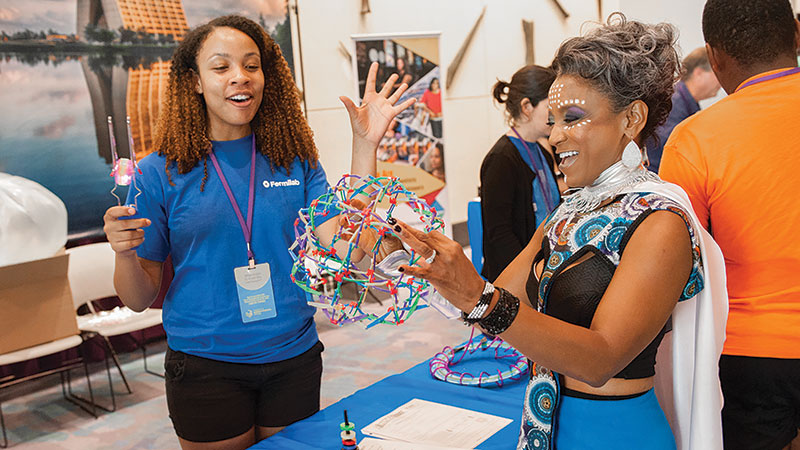Energy and Agency: How You Can Speak Up and Help Your Community
Winter
2020
Pathways - Advice from Experienced Voices
Energy and Agency: How You Can Speak Up and Help Your Community
Jeremiah O’Mahony, 2019 SPS Summer Intern and SPS Member, Sarah Lawrence College
 Jessica Esquivel, a neutrino physicist at Fermilab, spent a portion of an August weekend last year in a purple cape and a high, feathered collar, with white dots around her eyes. She was in costume as Shuri, Wakanda’s resident tech genius, at Chicago’s Black Panther–inspired Afro-futuristic convention, WakandaCon.
Jessica Esquivel, a neutrino physicist at Fermilab, spent a portion of an August weekend last year in a purple cape and a high, feathered collar, with white dots around her eyes. She was in costume as Shuri, Wakanda’s resident tech genius, at Chicago’s Black Panther–inspired Afro-futuristic convention, WakandaCon.
How did she get herself and her colleagues there? By knowing how to say “yes” strategically. She also credits knowing where to put her energy, a habit she’s developed over years of being in demand. “As you may know, being a black, LatinX, lesbian woman, people will pull you in every which way,” says Esquivel, who’s offered research and outreach projects related to both her credentials and her identities. “Add the fact that you are able to distill down complicated subject matter and be accessible in a variety of populations, and people come knocking!” That, and she studies neutrinos as a postdoc research associate at Fermilab. No biggie.
Back when she was starting out, she accepted every project she was offered. It got draining. She didn’t know where to direct her energy. So Esquivel tried accepting only those projects at which she knew she’d excel and that brought positive visibility to her communities.
“I know there is a lack of underrepresented minorities in STEM, especially black and brown women in physics,” she says. “That’s what I want to change.”
With that goal in mind, Esquivel built a reputation as someone who could both do complex science and explain it to several types of audiences. Then she flipped the script and started to hold other people and projects to account. “I now am able to ask targeted questions about what populations this event would be reaching out to, how accessible this event will be, is it coming from an intersectional lens?” she says.
You don’t have to be a neutrino physicist to help out your community. Esquivel shares the following advice: Know your skills, take projects that you know you’ll ace, and show the leading folks in your department what you can do. Once on their radar, you can do a lot to improve your community.
“And now when I go to the Office of Education/Communication here at Fermilab with a harebrained idea,” Esquivel says, “the powers that be listen!” Esquivel’s proudest harebrained idea paid off in 2018 when she brought Fermilab to WakandaCon.
Esquivel’s own journey to Wakanda began with her lobbying for better lab conditions. This is especially important for students from communities that don’t traditionally get a platform in physics.
In its last issue, the SPS Observer ran an article on concrete ways you can make your physics space more inclusive. Tanmoy Laskar, a queer astrophysics postdoc at the University of Bath, stressed that it’s up to each of us to carry forward the promise of flags and ramps. “It is the people who use that space who must first be willing to accept and encourage diversity, tolerate and champion inclusivity, and understand and promote equity,” Laskar says.1
That’s a tall order. Nicole Cabrera Salazar, a PhD astrophysicist who tackles outreach issues in physics, has a solution: Speak up for yourself and your friends. Listen to each other’s stories (the SPS Observer article has some tips on how), and share your needs with lab and department heads. “I advise my students to band together and petition their departments for change,” Cabrera Salazar says. “There’s a lot of power in community organizing—in coalition building.” Apart, you’re frustrated students. Together, you’re the next generation of physicists.
Be ready for pushback—especially if, Cabrera Salazar says, you’re an underrepresented student. A reform that helps underrepresented groups “may be seen as a niche issue,” she says. Just remember that helping even a few people in the community helps the entire community.
You don’t have to do it alone. Take advantage of the mentors your department provides. Lean on them, pick their brains, ask them how they got where they are. Some mentors, like Esquivel’s in undergrad, turn into lifelong friends who can advocate for you.
Laskar, who co-authored LGBT+ Inclusivity in Physics and Astronomy: A Best Practices Guide, explicitly asked for and sought out mentors—both professors and older students—who shared identities with him and were where he aspired to be during his career.
There will be a time when you can mentor a younger student. Last summer, Esquivel took a grad student and high schooler under her wing, passing on lessons she had been grateful to receive in her college days. She emphasized showing her interns how to exercise their agency in a physics setting. “I told them how important it was to advocate for themselves,” she says. The interns helped plan for and present at Fermilab’s booth at WakandaCon, and Esquivel eventually stepped aside and let the graduate student assume a mentor role for the high schooler. “I just wanted to impart my belief that you can affect change at any stage in your career.”
A big part of becoming a mentor for students who share your identity or identities is becoming and staying visible. For some students it’s unavoidable, but students in the LGBT+ community don’t always wear their sexual orientation or gender identity on their sleeve.

Depending on the school and the country, physics often isn’t a welcoming place to do so. Laskar travels all over the world to present his research, and sometimes he’s loudly out. At the Lino 2019 conference in Germany, he advertised a networking session for queer attendees over Twitter. At other conferences, he keeps his identity to himself. Similar periods of silence are temporary for some of his colleagues, but for others the return to the closet is more permanent. “I know people who left their identity behind,” Laskar says.
“The decision about coming out is extraordinarily individual,” says Diana Parno, who studies neutrinos at Carnegie Mellon and co-authored the Best Practices Guide alongside Laskar. If you’re not out, or questioning, or are only out to certain people or groups, you have all the time in the world. If you are out, you might want to help other students you know feel more comfortable expressing their LGBT+ identity. “The best way to do that is to be a role model,” Parno says. “Not to drag or pull anyone. Show a good example.”
Being an example isn’t anyone’s default setting, and it can be exhausting. The key to recuperating, according to Parno, is finding ways to build community outside of classrooms and labs. Cabrera Salazar joined a LatinX organization on her campus in grad school. Parno suggests bringing up nonphysics topics during SPS chapter meetings, like your favorite outdoor activity or Netflix show.
Esquivel found her escape in bringing her Fermilab co-workers to WakandaCon. They hosted a booth with demonstrations and held a panel on weathering the complexities of doing physics while black. Esquivel discussed her experience as only the second black woman to attend and complete Syracuse University’s physics graduate program.
The convention was, she says, rejuvenating. “It was like going to church. All the good parts of church. All your blackness fell away, and you could focus on everything else you’re interested in.”
References:
1. O’Mahony, Jeremiah. “Fostering Inclusive Spaces.” The SPS Observer, V LIII, 3. Fall 2019.
